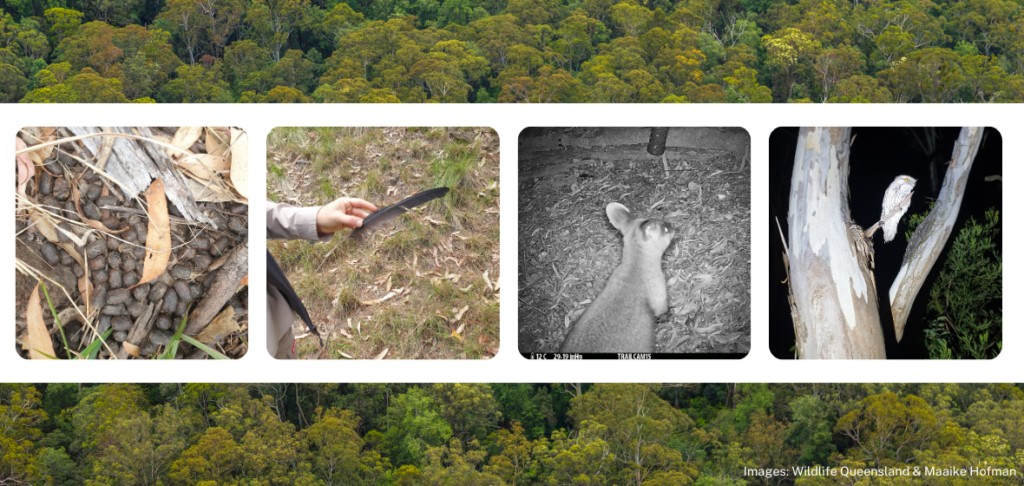
18 October 2024
Wildlife Queensland project officers are busy monitoring threatened species across several projects, from camera trap surveys in the Sunshine Coast to assessing the recovery of wildlife impacted by the Black Summer bushfires.
1. Camera trap surveys for quolls continue in the Sunshine Coast
In 2022, the Queensland Government awarded Wildlife Queensland’s Quoll Seekers Network (QSN) a Community Sustainability Action Grant. Its goal is to determine whether the endangered spotted-tailed quoll (Dasyurus maculatus) and northern quoll (Dasyurus hallucatus) still exist in the protected areas of the Sunshine Coast.
The project’s surveys are conducted in key areas such as Bellthorpe National Park, Imbil State Forest, and Woondum National Park, where infrared cameras are installed to search for any signs of these marsupial carnivores.
The quest for quolls
The spotted-tailed quoll and northern quoll were once widespread in South East Queensland. Today, the spotted-tailed quoll is mostly found in Queensland’s Southern Downs and Granite Belt, while the northern quoll has retreated to areas north of Central Queensland. Anecdotal reports suggest that quolls may exist in small numbers within the Sunshine Coast’s larger national parks and state forests.
Recent fieldwork findings
In September this year, Wildlife Queensland’s project officers collected camera trap data from Imbil State Forest. Although no quolls were detected, the cameras captured fascinating footage of local wildlife, including koalas (Phascolarctos cinereus), black-breasted button-quails (Turnix melanogaster), long-nosed bandicoots (Perameles nasuta), and short-eared possums (Trichosurus caninus). Pests such as domestic cattle, foxes, and feral cats were also recorded.
In October, Wildlife Queensland project officers, in partnership with Friends of Parks Queensland, Quoll Society of Australia, and Noosa and District Landcare, collected camera trap data from Woondum National Park. Despite no quoll sightings, 15 species were observed, including swamp wallabies (Wallabia bicolor), short-beaked echidnas (Tachyglossus aculeatus) and koalas. The survey contributed valuable data and involved community trainees in conservation work.
Continuing the search for quolls
While no quolls have been spotted in the Sunshine Coast surveys, the project is far from over. Each survey helps refine our understanding of the Sunshine Coast’s wildlife and informs future conservation actions. Wildlife Queensland remains committed to raising awareness and protecting the habitat of endangered species, with the hope that these iconic quolls still roam our forests.
2. Recovery of threatened species in the wake of Black Summer bushfires
Along with BirdLife Australia and the Glossy Black Conservancy, Wildlife Queensland is assisting with the Githabul-led Emu Vale Township Fire Management Strategy project, run by the Githabul People and Healthy Land and Water. It will assess the recovery of fauna affected by the 2019–2020 Black Summer bushfires. The Emu Vale area, located on the western slopes of Main Range National Park, was selected for its cultural significance to the Githabul People and the impacts of past fire management practices. The project aims to enhance fire management strategies while promoting the health of ecosystems impacted by fire.
Protecting culturally significant and threatened species
Key species targeted by the surveys include the brush-tailed rock-wallaby (Petrogale penicillata), glossy black cockatoo (Calyptorhynchus lathami), greater glider (Petauroides volans), yellow-bellied glider (Petaurus australis), and eastern bristlebird ( Dasyornis brachypterus)—species which have suffered from habitat loss due to wildfires. The project also highlights species of special interest, such as the platypus (Ornithorhynchus anatinus), powerful owl (Ninox strenua), and the Lamington spiny crayfish (Euastacus sulcatus), which hold ecological and cultural significance to the Githabul People.
Exciting discoveries in the field
Wildlife Queensland’s project officers recently conducted spotlight surveys and set camera traps across four key sites in Emu Vale. Their efforts resulted in direct evidence of brush-tailed rock-wallaby inhabitation at three locations, with additional scat samples identified as proof of their presence. Acoustic recorders, specifically audio moths, captured calls of the elusive yellow-bellied glider, while glossy black cockatoos left tell-tale signs of feeding activity. Although no greater gliders were observed, project officers are hopeful as spotlight surveys will occur again during November 2024.
Additionally, eDNA analysis of water samples across Emu Vale’s waterways revealed the presence of various decapod species, including the Lamington spiny crayfish. However, no platypus DNA was detected in this phase of sampling.
Wildlife Queensland Projects Manager Matt Cecil found the time in Emu Vale rewarding. “It’s an amazing place to work, with stunning landscapes and incredible scenery, and a good opportunity to collect records of threatened species. However, there were quite a few leeches and ticks to contend with!”
These surveys provide valuable insights into the recovery of wildlife affected by the Black Summer bushfires and the importance of effective fire management strategies. With continued efforts and collaboration, there is hope for the long-term protection of both endangered species and cultural landscapes.
What you can do:
- Request a copy of the Landholders’ guide: Saving the Brush-tailed Rock-wallaby
- Request a copy of the Landholders’ guide: Saving the Spotted-tailed Quoll
- Report sightings of a quoll, brush-tailed rock-wallaby, glider or platypus.
- Subscribe to our eBulletin Talking Wildlife to learn more about your local wildlife, plus Wildlife Queensland’s latest news, offers and events.
Related articles
Quoll seeking in South East Queensland continues | Wildlife Preservation Society of Queensland
